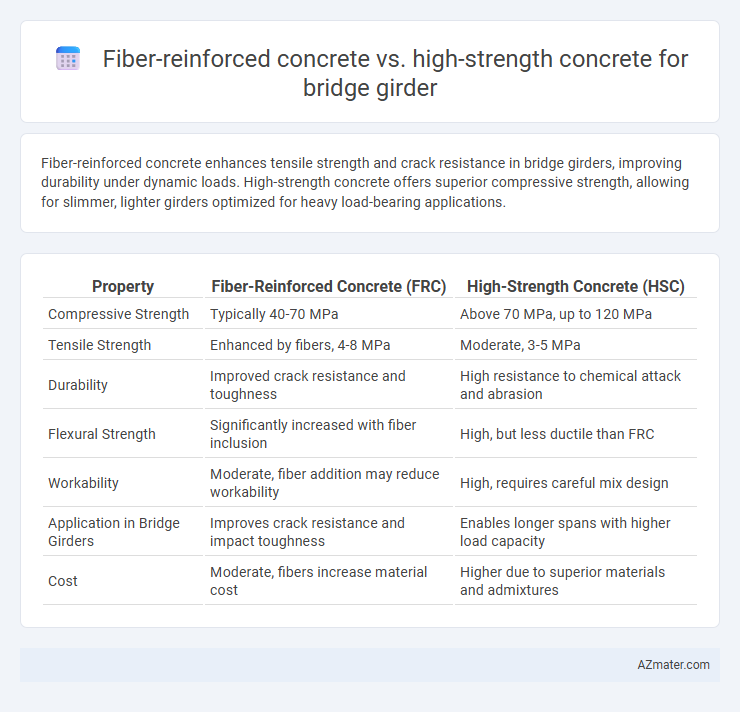Fiber-reinforced concrete enhances tensile strength and crack resistance in bridge girders, improving durability under dynamic loads. High-strength concrete offers superior compressive strength, allowing for slimmer, lighter girders optimized for heavy load-bearing applications.
Table of Comparison
| Property | Fiber-Reinforced Concrete (FRC) | High-Strength Concrete (HSC) |
|---|---|---|
| Compressive Strength | Typically 40-70 MPa | Above 70 MPa, up to 120 MPa |
| Tensile Strength | Enhanced by fibers, 4-8 MPa | Moderate, 3-5 MPa |
| Durability | Improved crack resistance and toughness | High resistance to chemical attack and abrasion |
| Flexural Strength | Significantly increased with fiber inclusion | High, but less ductile than FRC |
| Workability | Moderate, fiber addition may reduce workability | High, requires careful mix design |
| Application in Bridge Girders | Improves crack resistance and impact toughness | Enables longer spans with higher load capacity |
| Cost | Moderate, fibers increase material cost | Higher due to superior materials and admixtures |
Introduction to Bridge Girder Construction
Fiber-reinforced concrete enhances bridge girder construction by improving tensile strength, crack resistance, and durability, making it ideal for handling dynamic loads and reducing maintenance costs. High-strength concrete offers superior compressive strength and durability necessary for supporting heavy loads and long spans in bridge girders, ensuring structural integrity and longevity. Selecting between fiber-reinforced and high-strength concrete depends on specific performance requirements, load conditions, and desired lifespan for the bridge girder.
Overview of Fiber-Reinforced Concrete
Fiber-reinforced concrete (FRC) enhances tensile strength and crack resistance by embedding discrete fibers such as steel, glass, or synthetic materials into the concrete matrix, making it highly effective for bridge girder applications. This composite material improves durability and impact resistance, reduces maintenance costs, and controls shrinkage-induced cracking compared to conventional high-strength concrete (HSC). While HSC offers superior compressive strength above 6000 psi, FRC provides a balanced performance through improved toughness and post-crack behavior vital for structural resilience in dynamic bridge loading conditions.
Key Features of High-Strength Concrete
High-strength concrete (HSC) used in bridge girders offers superior compressive strength typically above 6,000 psi, enhancing load-carrying capacity and durability compared to standard concrete. Its dense microstructure reduces permeability, increasing resistance to environmental degradation such as chloride-induced corrosion and freeze-thaw cycles. The material's low water-cement ratio and advanced admixtures improve workability and early strength gain, making it highly suitable for critical structural components in bridge construction.
Comparative Strength and Load-Bearing Capacity
Fiber-reinforced concrete (FRC) demonstrates improved tensile strength and crack resistance compared to traditional high-strength concrete (HSC), making it ideal for bridge girders subjected to dynamic loads. High-strength concrete offers superior compressive strength, typically exceeding 70 MPa, enabling it to bear substantial static loads but with limited ductility. The combination of enhanced toughness in FRC and the high compressive capacity of HSC determines optimal load-bearing performance depending on specific structural demands and environmental conditions.
Durability and Longevity Considerations
Fiber-reinforced concrete enhances bridge girder durability by improving crack resistance and impact absorption, reducing maintenance needs over time. High-strength concrete offers superior compressive strength, allowing for slimmer girder profiles but may be more vulnerable to microcracking under cyclic loads. Selecting fiber-reinforced concrete can extend girder longevity in aggressive environments, while high-strength concrete suits applications prioritizing load capacity with proper curing and protective measures.
Flexural Performance and Crack Resistance
Fiber-reinforced concrete enhances flexural performance in bridge girders by distributing tensile stresses more effectively, leading to improved crack resistance and delayed crack propagation compared to high-strength concrete. High-strength concrete offers superior compressive strength but is inherently brittle, making it more susceptible to sudden failure under flexural loads without significant deformation. Incorporating fibers into concrete mixes improves toughness and durability, making fiber-reinforced concrete preferable for bridge girders requiring enhanced flexural resilience and crack control.
Installation and Workability Differences
Fiber-reinforced concrete (FRC) enhances installation efficiency due to its improved toughness and crack resistance, allowing for reduced formwork and faster placement in bridge girder construction. In contrast, high-strength concrete (HSC) requires more precise handling and curing conditions to maintain its performance, often complicating workability with a stiffer mix that demands careful vibration and consolidation. The inclusion of fibers in FRC improves pumpability and reduces segregation, whereas HSC's low water-to-cement ratio can lead to challenges in achieving proper flow and compaction during installation.
Cost and Economic Analysis
Fiber-reinforced concrete (FRC) for bridge girders often reduces long-term maintenance expenses due to enhanced crack resistance and durability, despite higher initial material costs compared to high-strength concrete (HSC). High-strength concrete typically offers lower upfront costs and increased load-bearing capacity, but may require more frequent repairs, raising lifecycle expenses. Economic analysis shows FRC can provide better value over the bridge's lifespan by minimizing repair frequency and extending service life, especially in aggressive environments where durability is critical.
Environmental Impact and Sustainability
Fiber-reinforced concrete (FRC) enhances durability and reduces crack propagation in bridge girders, lowering maintenance frequency and associated environmental costs through extended service life. High-strength concrete (HSC) enables slimmer, lighter girders that minimize material use and carbon footprint during production but may require higher cement content, increasing initial emissions. Selecting FRC over HSC can optimize sustainability by balancing reduced lifecycle resource consumption with controlled cement demand, crucial for environmentally conscious bridge construction.
Recommendations for Bridge Girder Applications
Fiber-reinforced concrete enhances crack resistance and durability, making it ideal for bridge girders subjected to dynamic loads and harsh environmental conditions. High-strength concrete offers superior compressive strength, suitable for girders requiring high load-bearing capacity and slender cross-sections. For optimal bridge girder performance, combining fiber reinforcement with high-strength concrete is recommended to maximize structural resilience and longevity.

Infographic: Fiber-reinforced concrete vs High-strength concrete for Bridge girder
 azmater.com
azmater.com